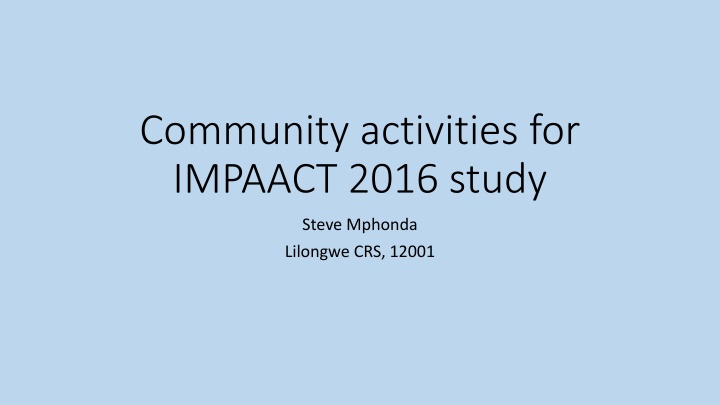
IMPAACT 2016 Study Community Stakeholder Activities Overview
Explore the IMPAACT 2016 study focusing on evaluating a group-based intervention to improve mental health and ART adherence in HIV-infected adolescents in low-resource settings. Engage with community stakeholders, assess the feasibility and acceptability of interventions, and involve youth and caregiver feedback in the process.
Download Presentation

Please find below an Image/Link to download the presentation.
The content on the website is provided AS IS for your information and personal use only. It may not be sold, licensed, or shared on other websites without obtaining consent from the author. If you encounter any issues during the download, it is possible that the publisher has removed the file from their server.
You are allowed to download the files provided on this website for personal or commercial use, subject to the condition that they are used lawfully. All files are the property of their respective owners.
The content on the website is provided AS IS for your information and personal use only. It may not be sold, licensed, or shared on other websites without obtaining consent from the author.
E N D
Presentation Transcript
Community activities for IMPAACT 2016 study Steve Mphonda Lilongwe CRS, 12001
Outline Introduction IMPAACT 2016 brief overview Community stakeholder activities Next steps
The site It s a multi trial site IMPAACT,HVTN,ACTG,HVTN,MTN Each network has a CAB point person and a staff liaison CAB since 1999
IMPAACT 2016 Evaluating a Group-Based Intervention to Improve Mental Health and ART Adherence in HIV-Infected Adolescents in Low Resource Settings
Primary objective Evaluate whether a TI-CBT Intervention is associated with improved depression, anxiety, and/or traumatic stress symptoms for youth living with HIV compared to a Discussion Control at six months.
Study population 15-19 year old youth living with HIV and mental health distress, and their caregivers (if available and agreed to by youth participant). Sample size Approximately 192 - 256 youth participants (96 - 128 per arm), plus their caregivers,
Community stakeholders Groups or individuals that are ultimately representing the interests of people who would participate in a trial and others locally affected by a trial.
Community Stakeholder Engagement The process of identifying components for possible adaptation. Assess feasibility and acceptability of the intervention
Stakeholders included: Community and youth advisory board members Youth organizations Site study staff HIV care provides MOH/NGO Mental health providers MOH/NGO Malawi police
Community Stakeholder Engagement Youth and Caregiver Intervention Manuals were provided for review. Local language Prompted for feedback around Feasibility and acceptability, wording for local context, concepts, and possible barriers to administering each component.
Outcomes Received positive feedback Acceptable Feasible Suggestions made to be incorporated
Next steps.after NHSRC approval Community sensitizations Large scale community stakeholder engagement activities
